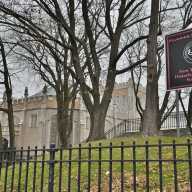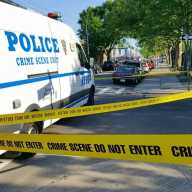Students from Public School 89 in Elmhurst, Queens received a quick lesson on the vital role each of them play in the upcoming 2000 census and how they may be the vehicles which can help boost Federal funding within their community. But do they understand what this means?
Congressman Joseph Crowley (D-Sunnyside) and his guest speaker, United States Census Director Kenneth Prewitt, spoke to fifth-grade students at P.S. 89 Monday morning on the importance of being counted in the 2000 census and how it will effect their community, school and family.
According to Prewitt a large number of individuals within the immigrant population of New York City have disregarded the census, which has led to a misallocation of Federal funds. "Many immigrants do not fill out the census because they lack written skills or they may distrust the government," he said.
This type of problem is prevalent in communities such as that of the 7th District in Queens, where it is estimated that at least 11,000 individuals were not counted during the 1990 Census. Community based programs such as English as a Second Language and Head Start rely on the census count because it is used to determine how Federal funds for such programs are distributed. Therefore the miscount has had a profound impact on the amount of funding and resources available for these types of programs within the 7th District, where P.S. 89 is located, as it has on communities across the country.
However, in regards to the undercount problem in the metropolitan area, the 7th District may be the tip of the iceberg. According to officials, 40,000 residents of Queens were not counted in the 1990 Census. In New York City, a total of 110,000 Hispanics, 185,000 African Americans and 2,000 Pacific Islanders failed to be counted. This includes 77,000 children, which is enough to fill a 150 average sized schools, according to Prewitt. New York City lost over $415 million in Federal funds for the 1990’s due to this undercount. The borough also lost one Congressional seat as a result of the undercount, thus, weakening the clout of the entire New York City delegation. So how do you get 60 fifth- grade students from Queens to understand the complexity of this problem?
Index cards were distributed among the students in attendance at P.S. 89. A majority of the students received a card marked with an "X." These students represented the percentage of the population counted within the census. Crowley asked them to rise, and in simple terms, explained the benefits of being counted. "All of you will receive hot lunches, clean tap water to drink and better educational programs," Crowley said. He then asked the few remaining students who had received a card marked with an "O" to rise. "You students with an O do not exist as far as the Federal Government is concerned. This means you do not receive the same benefits as those who were counted," Crowley said.
As he spoke to his young audience, Crowley went on to explain how the census works. "The census tries to make sure every person in the country is counted. The number of people counted determines how much money will be given to schools, for the construction of roads and bridges and other important public service programs," he said.
Prewitt went on to explain to the students why the census is a serious matter. "You all say the Pledge of Allegiance every day. Why? Because it says you respect your country and it connects you all. The Census is the same way. It connects you to this country. Think of it as you think of the Pledge of Allegiance, except the Census is not done everyday. It’s done every ten years so it’s important to do it right," he said.
"All of you students can help by telling your parents that the census is not complicated and that they can get the census form in another language if needed. Try to make them understand that it is a really important thing for them to do and that it is safe and confidential," Prewitt said.
Fritzpatrick Roque, a fifth-grade student at P.S. 89, understands the message that Crowley and Prewitt are trying to convey. "The Census is very important because they have to count everyone in the U.S. and if they miss some it could mess things up for people," Roque said. "X’s and O’s are a serious thing."
Will children be able to persuade their parents to take the census a bit more seriously? Prewitt said he thinks educating the children is just one of many ways to do it. "What one hopes is that as many vehicles as possible can be used to relay the message of the importance of being counted in the next census," he said. "But there are other ways also. All we can do is pull out all the stops and we’re confident we can do it."
One of the main reasons Prewitt visited P.S. 89 was because of its diversity. "We wanted to visit a place where the immigrant population is sharply presented. To look out at the kids in the audience and to see so many different cultures is amazing. There is a very exciting social transformation taking place here in Queens. In the last census, Queens was identified as the most ethnically diverse community in the United States. Our job is to make sure they are represented and that they receive the Federal funds they deserve," Prewitt said.
Crowley is also contributing to make the next census a success with the formation of the Census Advisory Task Force, which is composed of local elected officials, community board and civic leaders. His goal is to ensure every person in the 7th District is counted in the 2000 Census.
"A part of it is educating the children, trying to make them understand how important the census is. If you energize the children in turn they will energize their parents. But community leaders also must get involved and that is why I created the task force," Crowley said. "Every person counts, therefore it is my goal that every person be counted."
The U.S. Census Bureau seems to be taking the educational approach extremely seriously. They are in the process of distributing educational packets to 40 percent of public schools throughout the country. A majority of these schools are in areas where there has been a large undercount in the previous census. P.S. 89 is one of the schools receiving these packets, which provide lessons in introducing students, grades five through eight, to appropriate activities that correspond to their curriculum. These activities help the students understand the census, along with information pertaining to the U.S. population, its history and the role they play in it.
The census form for the year 2000 will be distributed in March and must be returned to the Bureau no later then April 1. It consists of seven questions and is available in six languages, according to Prewitt. Now all Queens residents and the U.S. Census Bureau can do is hope that less O’s show up and more X’s show up this time around.































